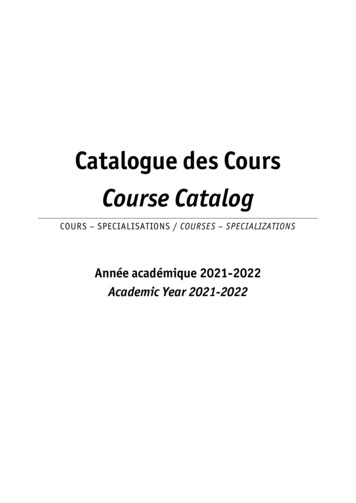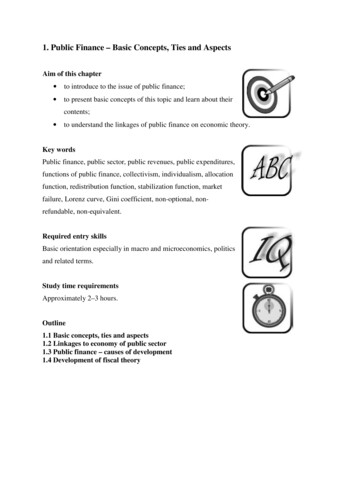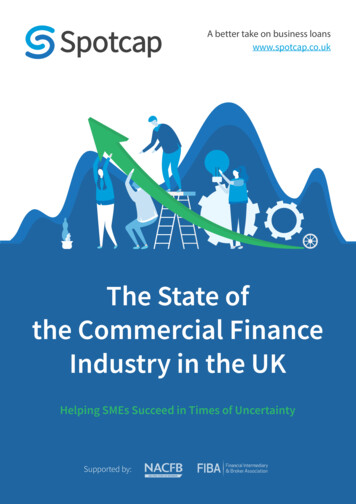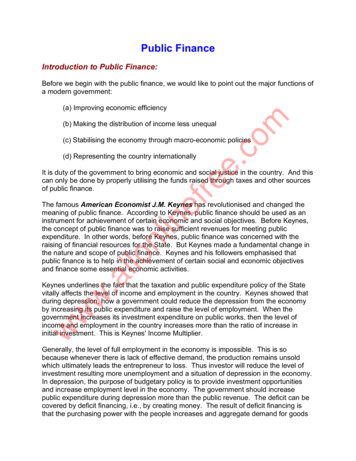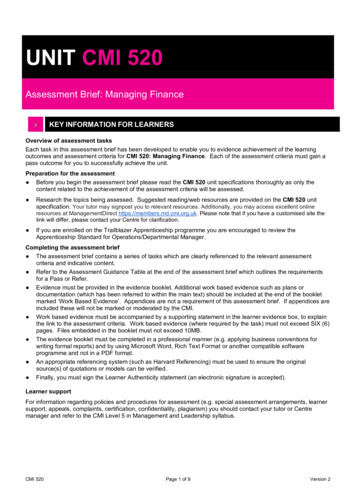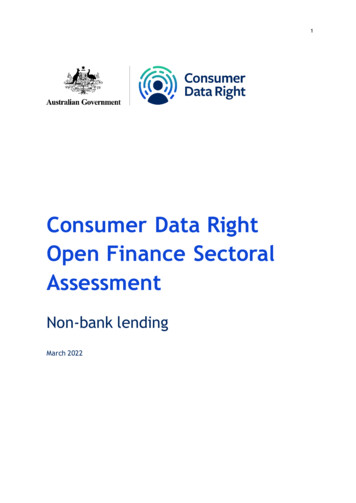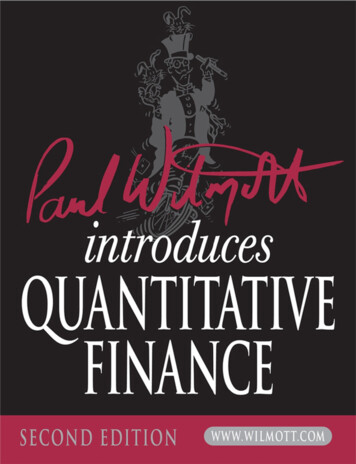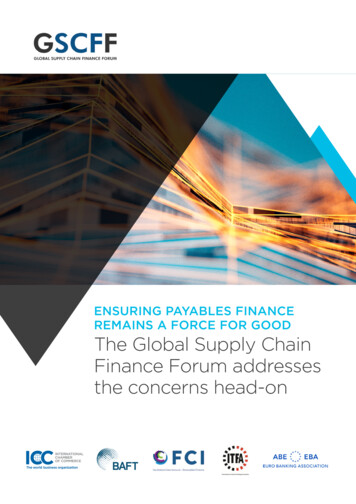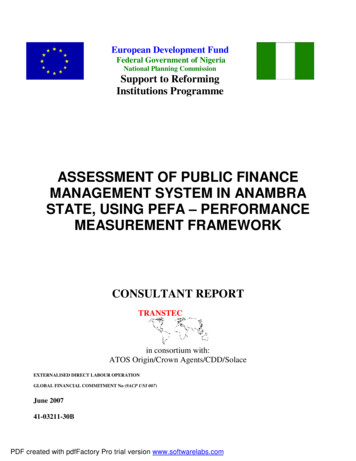
Transcription
European Development FundFederal Government of NigeriaNational Planning CommissionSupport to ReformingInstitutions ProgrammeASSESSMENT OF PUBLIC FINANCEMANAGEMENT SYSTEM IN ANAMBRASTATE, USING PEFA – PERFORMANCEMEASUREMENT FRAMEWORKCONSULTANT REPORTTRANSTECin consortium with:ATOS Origin/Crown Agents/CDD/SolaceEXTERNALISED DIRECT LABOUR OPERATIONGLOBAL FINANCIAL COMMITMENT No (9ACP UNI 007)June 200741-03211-30BPDF created with pdfFactory Pro trial version www.softwarelabs.com
ANAMBRA STATE OF NIGERIA:PFM Performance MeasurementPrepared by:Chinedum Nwoko,Hyacinth IchokuThis report is financed by the European Commission and the World Bank and is presented byChinedum Nwoko and Hyacinth Ichoku for the National Planning Commission and the EuropeanCommission. It does not necessarily reflect the opinion of the National Planning Commission and theEuropean Commission.41-03211-30BPDF created with pdfFactory Pro trial version www.softwarelabs.comii
Basic InformationCurrencyExchange Rate ((US , June 2008)Fiscal/Budget YearFiscal years Covered by reportWeights and MeasuresNaira 100 kobo117 Naira (Average)Calendar Year, January - December2004 – 2006Metric System41-03211-30BPDF created with pdfFactory Pro trial version www.softwarelabs.comiii
Table of ContentsTABLE OF CONTENTS. IVMAP OF NIGERIA . VILIST OF ABBREVIATIONS AND DEFINITIONS . VIIACKNOWLEDGEMENTS . IXSUMMARY ASSESSMENT . 1STORY LINE. 1INTEGRATED ASSESSMENT OF PFM PERFORMANCE AND THEIR IMPACTS . 2Credibility of the Budget . 2Comprehensiveness and Transparency . 2Policy-Based Budgeting. 3Predictability and Control in budget Execution . 3External Scrutiny and Audit . 4PROSPECTS FOR REFORM PLANNING AND IMPLEMENTATION . 4CHAPTER 1: INTRODUCTION. 6CHAPTER 2: COUNTRY BACKGROUND INFORMATION . 72.1 DESCRIPTION OF COUNTRY ECONOMIC SITUATION . 7Political Structure and Population . 7Oil and the Nigerian Economy . 8Poverty Level. 9Unemployment Statistics . 11Progress towards the MDGs . 122.2 DESCRIPTION OF BUDGETARY OUTCOMES . 13Fiscal Performance of Anambra State, 2004 – 2006 . 13Allocation of Resources . 152.3 DESCRIPTION OF THE LEGAL AND INSTITUTION FRAMEWORK FOR PFM . 17The Context of Economic and Fiscal Reforms in States. 17Legal and Institutional Framework for PFM and PFM Reform in Anambra States. 18CHAPTER 3: ASSESSMENT OF THE PFM SYSTEMS, PROCESSES, AND INSTITUTIONS. 233.1 BUDGET CREDIBILITY . 23PI-1: Aggregate Expenditure Out-turn Compared to the Original Approved Budget . 23PI-2: Composition of Expenditure Out-turn Compared to Original Approved Budget . 24PI-3: Aggregate Revenue Out-turn Compared to Original Approved Budget. 25PI-4: Stock and Monitoring of Expenditure Payment Areas . 273.2 COMPREHENSIVENESS AND TRANSPARENCY. 28PI-5: Classification of the Budget . 29PI-6: Comprehensive of Information Included in Budget Documentation . 30PI-7: Extent of Unreported Government Operations. 31PI-8: Transparency of Inter-Governmental Fiscal Relations. 32PI-9: Oversight of Aggregate Fiscal Risks from Other Public Sector Entities . 34PI-10: Public Access to Key Fiscal Information . 343.3 POLICY BASED BUDGETING . 35PI-11: Orderliness and Participation in Annual Budget Process. 36PI-12: Multi-year Perspective in Fiscal Planning, Expenditure Policy and Budgeting. 373.4 PREDICTABILITY AND CONTROL IN BUDGET EXECUTION . 38PI-13: Transparency of Taxpayer Obligation and Liabilities . 39PI-14: Effectiveness of Measures for Taxpayer Registration and Tax Assessment. 40PI-15: Effectiveness in Collection of Tax Payments . 41PI-16: Predictability in Availability of Funds for Commitment Expenditure . 4241-03211-30BPDF created with pdfFactory Pro trial version www.softwarelabs.comiv
PI-17: Recording and Management of Cash Balances, Debt, and Guarantees. 43PI-18: Effectiveness of Payroll Controls . 44PI-20: Effectiveness of Internal Controls for Non-Salary Expenditures . 46PI-21: Effectiveness of Internal Audit. 473.5 ACCOUNTING, RECORDING, AND REPORTING. 48PI-22: Timeliness and Regularity of Accounts Reconciliation . 48PI-23: Availability of Information on Resources Received by Service Delivery Units . 49PI-24: Quality and Timeliness of In-year Budget Reports . 50PI-25: Quality and Timeliness of Annual Financial Statements. 513.6 EXTERNAL SCRUTINY AND AUDIT . 52PI-26: Scope, Nature, and follow-Up of External Audit . 52PI-27: Legislative Scrutiny of Annual Budget Law. 53PI-28: Legislative Scrutiny of External Audit Reports. 54CHAPTER 4: GOVERNMENT REFORM PROCESSES . 564.1 DESCRIPTION OF RECENT AND ONGOING REFORMS . 56ANNEX 1: PERFORMANCE INDICATORS SUMMARY . 58ANNEX 2: SOURCES OF INFORMATION . 62ANNEX 3: LIST OF NIGERIAN GOVERNMENT OFFICIALS MET . 63ANNEX 4: EXCEL CALCULATIONS FOR PI-1 – PI-3 . 65ANNEX 5: TERMS OF REFERENCE . IX41-03211-30BPDF created with pdfFactory Pro trial version www.softwarelabs.comv
MAP of Nigeria11Taken from the website: www.mapofworld.com Copyright 2006 Compare Infobase Limited41-03211-30BPDF created with pdfFactory Pro trial version www.softwarelabs.comvi
List of Abbreviations and DefinitionsAGA(s) – Autonomous Government Agencies)ANS – Anambra StateASUBEB – Anambra State Universal Basic EducationBoardBC – Budget CalendarBC&COA – Budget Classification and Chart ofAccountsCAC – Corporate Affairs CommissionCBN – Central bank of NigeriaCOA – Chart of AccountsCRF – Consolidated Revenue FundDMD – Debt Management DepartmentDMO – Debt Management OfficeDSA – Debt Sustainability AnalysisEU – European UnionEU-SRIP – European Union Support for ReformingInstitutions ProgrammeF & AC – Finance and Appropriation Committee (of theState House of Assembly – the specializedlegislative committee in charge of the budget)FA – Federation Account – the constitutional fund thataccumulates all centrally and sharable revenuesof the Federation, with the exception of valueadded tax revenueFAAC – Federation Account Allocation Committee, aquasi-formal intergovernmental bodycomprising representatives of the FederalGovernment, each of the 36 state governments,local governments, and some keyfederal/national bodies; FAAC meets monthlyto share centrally collected revenues among thethree tiers of government.FCT – Federal Capital TerritoryFG – Federal GovernmentFGN – Federal Government of NigeriaFR – Financial RegulationsFSP – Fiscal Strategy PaperGDP – Gross Domestic ProductHC – High CourtHIV/AIDS – Human Immunodeficiency Virus/AcquiredImmune Deficiency SyndromeIFA – International Federation of AccountantsIFPRI – International Food Policy Research Institute,Washington, DCIGR – Internally generated revenueIIA – Institute of Internal AuditorsILO – International Labour OrganizationINTOSAI – International organization of Supreme AuditInstitutionsIPPIS – Integrated Personnel and Payroll InformationSystemIPSAS – International Public Sector AccountingStandardsISPPIA – International Standards for Public Practice inInternal AuditJTB – Joint Tax BoardLG(s) – local government(s)LGA(s) – Local Government Area(s)M & E – Monitoring and EvaluationMDA – Ministries, Departments, and AgenciesMDGs – Millennium Development GoalsMTEF – Medium Term Expenditure FrameworkMTSS – Medium Term Sector StrategiesNA – National AssemblyNASB – Nigeria Accounting Standards BoardNBS – National Bureau of StatisticsNCS – National Council of StateNEC – National Economic CouncilNEEDS – National Economic Empowerment andDevelopment Strategy, Nigeria’s homegrownpoverty reduction strategy; NEEDS has a lifespan of four years, 2003 – 2007. NEEDS II iscurrently at an advanced stage of preparation.NGO – Non-Government OrganizationNPC – National Planning CommissionOAG – Office of the Accountant GeneralOPS – Organized Private SectorOSSAP-MDGs – Office of the Senior Special Assistantto the President on the MDGsPAC – Public Accounts Committee – the specializedlegislative committee that scrutinizes auditreportsPE(s) – Public Enterprise(s)PEFA – Public Expenditure and FinancialAccountabilityPEMFAR – Public Expenditure Management andFinancial Accountability Review, a 2006 WorldBank study in Nigeria published in 2007PER – Public Expenditure ReviewPFM – Public Financial ManagementPIT – Personal Income TaxPITA – Personal Income Tax Act (1993)PPP – Purchasing Power ParityPS – Permanent Secretary, usually the top civil servantin a government Ministry or quasi-ministerialdepartmentSAI- Supreme Audit Institution (in Anambra State, theAuditor General)SAP – Structural Adjustment ProgrammeSBIR – State Board of Internal RevenueSC - Supreme CourtSEC – State Executive CouncilSECO – Swiss Economic Cooperation OfficeSEEDS – State Economic Empowerment andDevelopment Strategy; state governments’version of NEEDS (see NEEDS above)41-03211-30BPDF created with pdfFactory Pro trial version www.softwarelabs.comvii
June 30, 2008SG(s) – State Government(s)SHA – State House of AssemblySNG(s) – Subnational government(s)TIAD – Treasury Internal Audit DepartmentUN – United NationsUNDP – United Nations Development ProgrammeVAT – Value Added TaxWB – World Bank41-03211-30BPDF created with pdfFactory Pro trial version www.softwarelabs.comviii
June 30, 2008Acknowledgements1.There are many people to appreciate. An assessment of this complexity cannot be a solitaryexercise. Although it impossible to mention all those that contributed directly and indirectly to thesuccessful completion of this work, a few names and groups that stand out deserve mention. First,there is this vital group of usually anonymous and often-invisible facilitators, but without whose realcontributions, an exercise of this sort would be impossible. They include office assistants, guides,lowly and forgotten officials, aides, etc., who performed those invincible, menial, and boring choresthat no one else would or indeed could have done.2.Very outstanding in this group was Collins, the indefatigable driver at the EU-SRIP Office inAwka, who not only made the arduous journeys from Awka to Enugu airport at very odd times,including at nights and early mornings, but was always there for hotel pick up and drop offs, and toguide the consultants through Awka town. Kingsley, his co-driver, also deserves special and earlymention. Joan Obianuju Onyebuchi (Secretary), Tayo (Accountant), Agatha Ajayi (DeputyCoordinator), Obiageli Ndibe, Ugochukwu Okonkwo, Felicia, all staffers at the EU-SRIP in Awka,were all wonderful people, supplying documents, and attending to demanding details at no notice.3.The Anambra State Commissioner for Finance, Eze Echesi and the Permanent Secretary,Ministry of for Economic Planning and Development, Mrs. Vivian Nwandu, deserve special mentionfor leading this work and constituting a technical team to work with the assessors in data collection andevaluation. Special thanks must also go to the Chairman of the technical team, and State Director ofPlanning, Andy Umeobi for the mature and unrestrictive manner he conducted the assessmentmeetings. The consultant also wish o specially thank all the members of the technical team for themature and open debates and assessments.4.Next, the consultants must gratefully record their gratitude to the World Bank team for theirvery valuable comments and feedback on both the interim and draft reports. Ms. Hawa Wague-Cisse,Senior Economist led this team, which also includes George Larbi, Senior Public Sector ManagementSpecialist, and others. Ms. Helen Okeke, team assistant, as usual played the facilitating role thathelped introduce the WB-appointed member of the consultant team to the Anambra State Government.5.The consultants reserve their most special thanks to Prof. Olaseni Akintola-Bello, Coordinatorof EU-SRIP in Awka, who not only afforded opportunity for this work, but also actively facilitated theentire exercise. He opened doors, set up meetings, accompanied the team to several of them, with theLegislators, and the PS, Planning and Economic Development, and occasionally participated inassessment deliberations. Perhaps, his greatest contribution was providing the EU-SRIP office for theassessment meetings and making the Anambra State Technical team feel relaxed and at home.6.The consultants also thank EU-SRIP and the World Bank for providing them the opportunity ofthis exercise and through it of contributing to the development of Anambra State of Nigeria.7.Finally, and most importantly, the ALMIGHTY GOD gave everything that has enabledsuccessful completion of this task. To HIM be all glory and praise, forever and ever. Amen.41-03211-30BPDF created with pdfFactory Pro trial version www.softwarelabs.comix
June 30, 2008Summary AssessmentThis summary assessment does several things. First, it provides an integrated and strategic picture ofthe PFM performance of Anambra State of Nigeria between 2004 and 2006. Second, in doing this, itseeks to capture and describe the main message or big picture of Anambra State’s PFM system in thoseyears. Third, it summarizes the assessment of the PFM system along the lines of the six coredimensions of PFM performance. Fourth, it also provides an assessment of the extent to which thePFM weaknesses identified in Chapter 3 affects achievement of outcomes of aggregate fiscaldiscipline, strategic allocation of resources, and effective service delivery. Finally, it examines theprospects for reform planning and implementation in Anambra State and the institutional and otherfactors that could support public financial management reform.Story LineWhat is the main message of this summary discussion? There are several strong highlights in theperformance of the Anambra state PFM system between 2004 and 2006. These include strongperformances by the respective Offices of the Accountant General and Auditor General in clearing thebacklog of outstanding accounts in 2004 and producing timely financial statements and audit reportsthereafter. Similarly, the State’s payroll control process appeared quite strong and stable. In addition,beginning in 2006, the Anambra State Government started the planning of a series of fiscal andeconomic reforms, including public financial management (PFM) reforms, which could furtherstrengthen the performance of the PFM system. Among the more important of these reform plans aremulti-year budgeting, new chart of accounts and budget classification, fiscal responsibility, andprocurement reforms.The reform plans are in recognition of the weaknesses exhibited by the PFM system in several keyareas between 2004 and 2006. The major weaknesses cover budget formulation and implementation,internal controls, and external scrutiny and audit. The procurement process appears to be particularlyweak in the State; the PFM system did not assess well in most of the procurement related indicators:PI-4, PI-10, PI-12, PI-16, PI-19; PI-20, PI-21, and PI-26. The weaknesses of the PFM system couldvery easily have undermined achievement of the three budgetary outcomes of aggregate fiscaldiscipline, strategic allocation of resources to development priorities, and effective service delivery.Perhaps, the prevailing political climate in Anambra State supplies some context for the level ofperformance of the Anambra State PFM system. Anambra State Government experienced deeppolitical crisis between 1999, when Nigeria returned to civil administration, and 2007. The years 1999to 2003 were very difficult years, often euphemistically described by Anambra residents as their “yearsof locust”. Schools closed for extended periods (at a point for up to 12 months), arrears of wages andsalaries, and other emoluments accumulated. Contractor debts also built up. The State did not makemuch progress while political leaders engrossed in mysterious squabbles. The 2003 elections did notimmediately resolve the political crisis, but rather led to deeper chasms, which the courts onlymanaged to resolve decisively in June 2007. It would appear that this situation adversely affected theperformance of the PFM system.PDF created with pdfFactory Pro trial version www.softwarelabs.com
June 30, 2008Integrated Assessment of PFM Performance and Their ImpactsThis subsection is a summary of the indicator-led assessment in Chapter 3. It does not repeat thedetailed assessment there; rather, it provides a convenient snapshot of the discussions. As explainedabove, the organization of the section follows the arrangement of the six core dimensions of PFMperformance as defined by PEFA.Credibility of the BudgetThe Anambra State PFM system did not produce credible budgets between 2004 and 2006. Not onlywere the emerging budgets unrealistic, the SG did not implement them as planned. There are severalpieces of evidence to support this assertion. First, the SG could not stick to approved budgetaggregates, especially in 2004 and 2006, when actual aggregate expenditure deviated from plannedexpenditure by nearly 30 percent and 11 percent respectively (Table I). Second, the SG did not adhereto approved budget composition and relationships. Table I also reveals a higher level of variationamong budget heads than between actual spending and approved budget. This failure to respect theoriginal consistency and harmony between budget components resulted in the high level of virementsin 2005 and 2006. Third, although actual revenue performance exceeded predicted budget revenue ineach of the three years, this was entirely due to prediction errors and the rising price of oil rather thanthe effectiveness of the PFM system. .Table I: Summary Budget Performance of Anambra State, 2004 - 2006Percentage Deviation: Aggregate Outturn vs. Original Approved BudgetPercentage Variance: Excess of variance in expenditure over overall deviationPercentage deviation in revenue prediction (excess of actual revenue over budget 16.1How could this performance have affected overall achievement of budget outcomes? The performancecould have affected budgetary outcomes in several ways. First, it could have contributed to shortfallsin funding priority spending identified during budget planning. Second, it could have contributed topolicy dysfunction and inability to achieve overall objectives and goals of the budget. Third, theperformance may be, at least partially, responsible for failure to attain projected service delivery levels.Fourth, the low budget credibility may have undermined the budget process leading to general lack oftrust in the budget as true expression of government policy intentions, and by so doing could havepromoted overall budget indiscipline.Comprehensiveness and TransparencyGenerally, the PFM system did not achieve the objectives of comprehensiveness and transparency ofthe budget process and during the period 2004 to 2006. First, there were major problems with thebudget and accounts classification system. The classification does not conform to internal goodpractices. Although they have some program control features, the dual budgeting technique anddichotomization used by the state made administrative and economic tracking of costs difficult.Second, although budget documentation to the State House of Assembly was fair, it was notcomprehensive enough to provide the complete overall picture of fiscal risks. Third, fiscal riskoversight over government parastatals was very poor; only five of approximately 33 parastatals audittheir accounts annually. Fourth, government dealings with its local governments were not sufficiently41-03211-30BPDF created with pdfFactory Pro trial version www.softwarelabs.com2
June 30, 2008transparent, falling short of expected standards, and violating the State’s own laws in several importantways. Fifth, members of the public did not have as much access to key fiscal information as theycould have had.In what ways could these have affected budgetary outcomes in Anambra State during the period?First, lack of transparency restricts availability of information on government performance in fiscaldiscipline, management of fiscal risks, and the use of resources. This prevents the members of thepublic from providing government with valuable facts-based inputs, suggestions, ideas, andinformation. Second, lack of complete information affects strategic allocation of resources by limitingthe ability of MDAs to compete fairly and transparently for resources during budget preparation. Theunfair competition that this implies could hinder allocative efficiency by leading to suboptimalallocation of resources. Finally, lack of comprehensive and transparent information increases thechances of wastes in the use of resources. Wherever they occur, wastages hinder efficient andeffective service delivery and value for money.Policy-Based BudgetingThe planning process in Anambra State between 2004 and 2006 was weak. The SG issues an annualbudget circular (BC) allowing MDAs a reasonable four weeks to prepare and submit their proposals.However, the budget process has a number of defects. First, the BC does not include a clear, detailed,and compelling budget timetable or calendar to guide the budget processor. Second, the circular doesnot contain hard budget constraints in the form of sectoral ceilings. Third, it does not provide MDAswith sufficient guidance on government development priorities during the period. Fourth, the lack oftimetable made it difficult to regulate and control the annual budget exercise often leading to delays insending the budget to the SHA. This contributed to significant yearly delays (of about three monthsafter commencement f the year) in approving the budget. In addition, planning and budgeting inAnambra State do not yet follow a multi-year perspective. 2How could these have affected budget outcomes? This weakness in planning could have contributed tothe general failure to respect fiscal estimates and budget composition as shown above. Further, thelack of multi-year perspective forced a short term planning focus on government. This could haveundermined allocative decisions as witnessed in what appears to be consistent under costing of newpolicy initiatives (see Chapters 2 and 3). Obviously, this lack of multi-year perspective and sectorstrategies contributed to inadequate planning and discussions over efficiency in the use of recourses.This could also have reduced the impact of service delivery initiatives.Predictability and Control in budget ExecutionThe PFM system did not perform exceptionally well in this core dimension. Debt management andpayroll controls during the period were good. However, the unprecedented revenue flows from thecentre may have affected the State’s desire to develop its internal revenue generation effort. The taxsystem was weak. Further, the system of cash management and centralized investment commitmentapprovals place could not allow MDAs to predict availability of funds for commitment expenditures.Internal audit was particularly weak as were other internal controls for non-salary expenditures.Finally and very importantly, the procurement process was not transparent and open.2The rolling plans do not involve costed multiyear strategies, and do not include current cost projections.41-03211-30BPDF created with pdfFactory Pro trial version www.softwarelabs.com3
June 30, 2008Did these affect budgetary outcomes, how? These failures may have contributed to the unplannedbudget reallocation that was a major feature of budget implementation during the period. They couldalso hav
IFA - International Federation of Accountants IFPRI - International Food Policy . Organization INTOSAI - International organization of Supreme Audit Institutions IPPIS - Integrated Personnel and Payroll Information System IPSAS - International Public Sector . NPC - National Planning Commission OAG - Office of the .
